
Computing News Archive 1999-2000
Sending e-mail: selecting and configuring your SMTP server
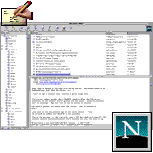 To send e-mail from on or off campus, you must configure your e-mail software
to use the correct Simple Mail Transfer Protocol (SMTP) server. Without
the correct SMTP server address, you cannot send e-mail.
To send e-mail from on or off campus, you must configure your e-mail software
to use the correct Simple Mail Transfer Protocol (SMTP) server. Without
the correct SMTP server address, you cannot send e-mail.
To set up SMTP, you have to make a choice to either configure your e-mail
with a Penn-based SMTP server or with an Internet Service Provider (ISP)
based SMTP server. Whenever possible, Information Systems and Computing
(ISC) suggests using Penn-based SMTP servers.
In some cases, you must choose ISP-based SMTP servers.
An example is:
- Your ISP requires you to use its own SMTP server. Some ISPs that have
this policy include AltaVista, Earthlink, FreeINet, Mindspring, and
Netcom.
For all e-mail applications, you will need to make sure that the "outgoing
mail server" or "SMTP server" is set to the appropriate name. For a list
of SMTP servers and information on how to configure for both Netscape
Communicator and Eudora, see the SMTP
page.
--Laura Victor and John Mulhern III, ISC Client Services Group (August
8, 2000)
Dr. Solomon's anti-virus products no longer supported
 Dr. Solomon's software products, Anti-Virus Deluxe and Anti-Virus Toolkit,
are being discontinued and are no longer supported by Network Associates
and ISC as of April 30, 2000. Before installing any new anti-virus software
to replace these products, first remove them by using the Add/Remove program
utility within Windows. Unpredictable incompatibilities can occur if you
fail to remove the old software first.
Dr. Solomon's software products, Anti-Virus Deluxe and Anti-Virus Toolkit,
are being discontinued and are no longer supported by Network Associates
and ISC as of April 30, 2000. Before installing any new anti-virus software
to replace these products, first remove them by using the Add/Remove program
utility within Windows. Unpredictable incompatibilities can occur if you
fail to remove the old software first.
The most current version of VirusScan, 4.03 for Windows 95/98/NT, can
be downloaded from Penn's Virus information web page after Anti-Virus
Deluxe and Anti-Virus Toolkit have been removed. Links to VirusScan, installation
instructions, and the users' guides, are on the Virus
information page.
--Mary A. Griffin, Senior IT Support Specialist, ISC Client Services
Group (May 8, 2000)
Penn modem pool changes
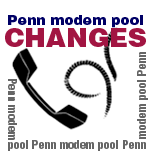
Effective July 1, 2000, Penn will begin to transition from the Internet
Service Provider (ISP) business by charging for access to its modem pool
services with the intention of eliminating the dialup pool altogether
by July 1, 2002.
Internet needs have grown at incredible rates in the last ten years.
New network technologies such as DSL (Digital Subscriber Lines) and cable
modems are making it possible to connect to the Internet at speeds 10-50x
faster than the rate of Penn's current 33.6 Kbps modem pool. The availability
of these higher speed technologies has evolved to meet the demand for
increased data transfer rates necessary for new applications and services
commonly used today. This demand will only continue to increase and as
it does, commercial high-speed Internet services will become even more
readily available in a range of technologies at decreasing costs and with
improving customer support for users. You will be able to receive cheaper,
faster, and better services through commercial vendors.
During a two-year transitional period, ISC is planning a phased reduction
of service. In addition to offering Penn's for-fee service, ISC has negotiated
preferred relationships with outside ISPs for the Penn user community.
See the remote access program
web site for more detailed information, including service options,
a description of the technologies, and help in choosing a vendor.
--James J. O'Donnell, Vice Provost, ISC (March 21, 2000)
Windows 2000 Professional
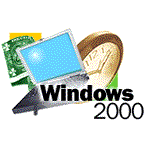
Windows 2000 Professional, released on February 17, 2000, is the latest
Microsoft operating system. It is intended by Microsoft to be the successor
to Windows NT 4.0 Workstation. Windows 2000 Professional is not
intended as a direct replacement for Windows 98 - Microsoft plans to release
an update to Windows 98, called Windows Millenium Edition, this year.
Information Systems & Computing (ISC) will support Windows 2000 Professional
for its clients, including off-campus students, only on new Intel-based
PCs that ship with Windows 2000 Professional pre-installed. ISC strongly
recommends that all other users adopt a "wait and see" attitude, continuing
to use previous versions of Windows until after the initial bugs in Windows
2000 Professional are identified and fixed. (read MORE)
--John Mulhern III, Senior IT Support Specialist, ISC Provider Desk
(February 17, 2000)
SSL certificate expiration

On December 31st, 1999, Verisign
Secure Sockets Layer (SSL) certificates for Netscape Navigator and
Netscape Communicator versions 4.05 and earlier will expire. Note that
this is not a Year 2000 problem: it just happens that the date
of expiration is coincident with the Year 2000 rollover.
SSL certificates are used for many secure web sites, including PennInTouch
and others in use at the University.
Based on our research and testing, ISC recommends a two-pronged solution
to this issue:
- For users with computers capable of running Netscape Communicator
4.06 or above, ISC, Netscape, and Verisign suggest upgrading your browser
to Communicator 4.06 or above. Netscape Communicator 4.06 and above
have SSL certificates that do not expire until 2010.
- For users with 486 PCs or 68040 Macintoshes with at least 16 Mbytes
of RAM, ISC suggests Netscape Communicator 4.08, available from
Netscape.
- For users with Pentium PCs or PowerPC Macintoshes with at least
16 Mbytes of RAM, ISC suggests Netscape Communicator 4.61, available
on the PennConnect CD-ROM.
- For users who cannot upgrade their browsers, it is possible to click
"Continue" when the certificate expiration dialog appears. However,
SSL will not properly authenticate the secure web site. Without an upgraded
browser and certificate, it is possible for malicious web sites to spoof
secure web sites and trick the user into entering sensitive data. Therefore,
while using SSL with an expired certificate is better than not using
SSL at all, ISC does not recommend entering sensitive data at secure
web sites if a "certificate expiration" dialog appears.
ISC is also aware of a similar SSL certificate issue with Microsoft
Internet Explorer 4.5 for the Macintosh. Microsoft has issued
a patch.
--John Mulhern III, Senior IT Support Specialist, ISC Provider Desk (December
9, 1999)
SMTP-RELAY service notice

On December 15th, 1999, ISC Networking will change the SMTP-RELAY server
to a registration-based service. Only those hosts that are registered
to use the service will be able to forward their mail through SMTP-RELAY.
For the past several years, SMTP-RELAY.UPENN.EDU has provided an electronic
mail forwarding service for campus mail servers that are unable to be
configured to deliver mail independently to other Internet hosts. In reality,
there appears to be very few such hosts on campus, but in practice, a
great many hosts forward their mail through SMTP-RELAY. This is fairly
inefficient, adding an extra hop to mail delivery and causing needless
network traffic and load on the server. It can also add complexity to
the troubleshooting process when e-mail problems occur. SMTP-RELAY will
be re-focused to serve only those mail hosts that truly need it.
All hosts
that have used SMTP-RELAY during the fall semester will automatically
be "grandfathered" (that is, "registered"). Hosts that have been using
SMTP-RELAY will not be immediately affected. Their mail will continue
to be forwarded.
Administrators who can set up their own servers to deliver mail directly
to the recipient rather than using an intermediate relay are asked to
do so as soon as possible. Over the next few months, administrators for
those grandfathered servers that are still using SMTP-RELAY will be contacted
to discuss this possibility.
New hosts that wish to use SMTP-RELAY will need to file a simple registration
form with ISC Networking. Those hosts that cannot deliver mail directly
on their own will be granted registration. Those hosts that can be configured
to deliver mail without the assistance of SMTP-RELAY may in many cases
not be granted registration. Please see the document configuring
Sendmail for more information.
--Deke Kassabian, Technical Director, ISC Networking (December 3,
1999)
Apple's iBook
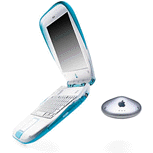
In November 1999, Apple Computer's iBook became commonly available. This
system, available in either tangerine or blueberry, represents the "consumer
portable" portion of Apple's four-part product line. Like Apple's iMac,
the iBook is built around the Universal Serial Bus (USB) peripheral connectivity
standard. Aside from the choice of color, it is only available in one
configuration (read MORE).
--John Mulhern III, Senior IT Support Specialist, ISC Provider Desk (November
29, 1999)
Administrative computing and network services unavailable 11/26/99
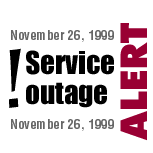
A twenty-four hour power outage in the ISC computer room at 3401 Walnut
over the Thanksgiving holiday will interrupt service on some key Penn
computing systems. Major administrative systems will be unavailable and
remote access to PennNet through the modem pool will be severely limited.
In addition, some important network services will not be operating and
University voicemail will be inoperative.
The outage will last from 8 a.m. Friday, November 26, to 8 a.m. Saturday,
November 27.
The outage is required so that obsolete technology that provides electrical
power service to the computer room, including backup power for emergencies,
can be entirely replaced. Power to stores and offices at 3401 Walnut will
not be interrupted.
Network traffic to and from the Internet and around PennNet (other than
that involving the 3401 Walnut computer room) will NOT be affected. ISC
regrets the necessity of the outage but hopes that the timing will minimize
the impact.
For more detailed information on the specific services and systems affected,
see the outage page.
--James J. O'Donnell, Vice Provost, Information Systems and Computing
(November 16, 1999)
Mac OS 9 release
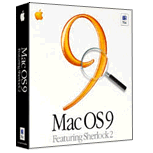
Mac OS 9 (code name "Sonata"), scheduled for release on October 23, 1999,
is the latest version of Apple's flagship operating system. It is the
sixth in a planned set of six or seven bi-yearly reference system software
releases from Apple.
Information Systems & Computing (ISC) will support Mac OS 9 for
its clients, including off-campus students, on new Macintoshes that ship
with Mac OS 9 pre-installed. ISC recommends that all other users adopt
a "wait and see" attitude, continuing to use previous versions of the
Mac OS until after the initial bugs in Mac OS 9 are identified and fixed.
When ISC does recommend an upgrade it will be for PCI-based Power Macintoshes
that have at least 48 megabytes of RAM. ISC does not recommend
Mac OS 9 for NuBus-based Power Macintoshes or PowerPC-based clones. Please
refer to ISC's
Mac OS System Specifications to find out which version of Mac OS is
recommended for your Macintosh computer. The full install of Mac OS 9
uses between 100 and 300 megabytes of hard disk space, depending on the
type of Power Macintosh and choices made during the install.
For more detailed information, including conflicts, upgrade information,
and new features, see the Mac
OS 9 page.
--John Mulhern III, Senior IT Support Specialist, ISC Client Services
Group (February 23, 2000)
Microsoft Office 2000 registration (all versions)
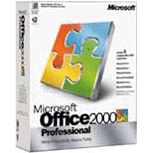
In an effort to hinder software piracy, Microsoft has made it a requirement
that all users of Office 2000 register the product. Should you choose
not to register Office upon installation, you will be given the opportunity
to do so each time you start any Office program (Word, Excel, Access,
Outlook, etc.). The MS Office programs will only start 50 times
while unregistered. Upon the 50th time and subsequent attempts to start
Office, you will be given the opportunity to register the product, but
no Office programs will open (read MORE).
--Andrew Riley, IT Support Specialist, ISC Client Services (September
17, 1999)
Supported products update

The Supported Products page on the
Penn Computing Web has been updated to reflect the recommended products
for the 1999-2000 academic year. The index provides an at-a-glance view
of the supported software and hardware products for both Mac OS and Windows.
Each product is linked from this index page to a "spec sheet," which provides
a brief description of the product; availability, configuration, support,
and year 2000 compliancy information; and links to related resources.
Where appropriate, products are available for download from Penn's FTP
server right from the spec sheets.
--Mark Aseltine, Director, ISC Provider Support and Client Services (September
10, 1999)
PennConnect CD-ROM network applications fall 1999

Information Systems and Computing has released the PennConnect CD-ROM
for fall 1999, which contains the recommended networking and anti-virus
software for off-campus students, staff, and faculty, as well as on-campus
ResNet students. The CD-ROM includes PPP (Point-to-Point Protocol) software,
which allows for remote connectivity to PennNet; the recommended Web browser;
and other Internet applications including clients for Telnet, e-mail,
and NetNews.
The CD-ROM features a new graphical interface that guides you through
installation and configuration of the software, as well as configuration
of your system to connect to PennNet via modem or from an on-campus ResNet
building.
The CD-ROM is cross-platform and works on Mac OS, Windows 95/98, and
Windows NT. Copies are available for many faculty and staff directly from
their local support provider or
at the Computing Resource Center, Suite 202, Sansom Place West, 3650 Chestnut
Street. The CRC's hours are M-F, 9-4:30 until September 24, and 1-4:30
after September 24. The software is also available for download via the
network. The Supported Products page
provides additional information and links to the software on Penn's FTP
server (ftp.upenn.edu).
--Mary A. Griffin, Senior IT Support Specialist, ISC Client Services
Group (September 1, 1999)
Mac OS 8.6 release
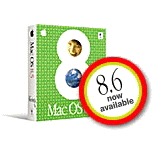
Mac OS 8.6 (code name "Veronica"), released on May 10, 1999, is the latest
version of Apple’s flagship operating system. It is the fifth in
a planned set of six bi-yearly reference system software releases from
Apple.
ISC recommends an upgrade to Mac OS 8.6 for existing systems that are
based on the PowerPC (Power Macintoshes) and have at least 32 megabytes
of RAM. Please refer to ISC's
Mac OS System Specifications to find out which version of Mac OS is
recommended for your Macintosh computer.
Mac OS 8.1 was the last version of the Mac OS to support Macintoshes
with the 68040 processor.
The full install of Mac OS 8.6 uses between 85 and 265 megabytes of hard
disk space, depending on the type of Power Macintosh and choices made
during the install.
Mac OS 8.6 is compatible with the current versions of Penn’s network
applications (PPP for Macintosh 5.0, Network Applications Installer 4.0,
etc.).
For more detailed information, including conflicts, upgrade information,
and new features, see the Mac
OS 8.6 page.
--John Mulhern III, Senior IT Support Specialist, ISC Client Services
Group (August 25, 1999)
|